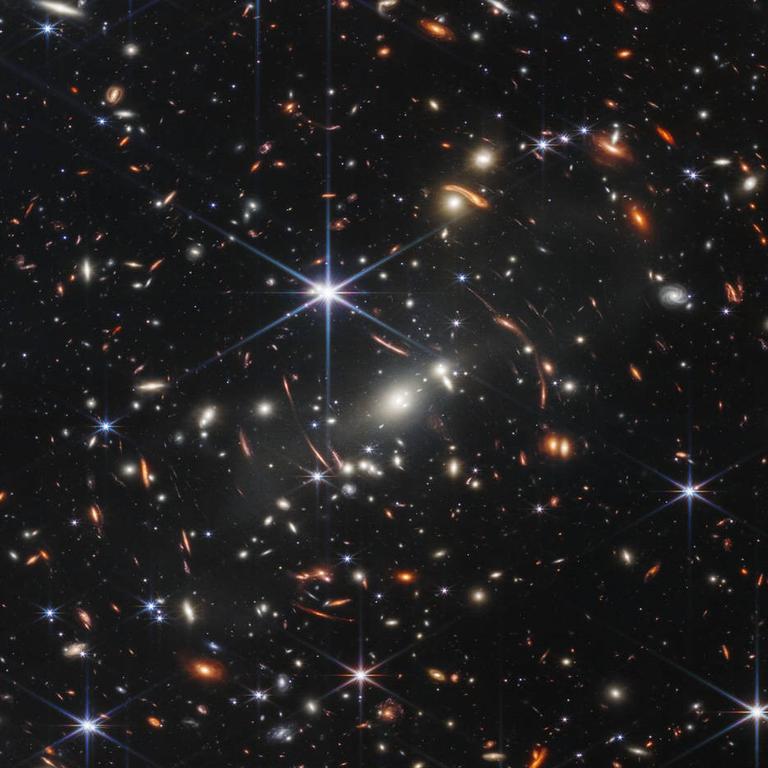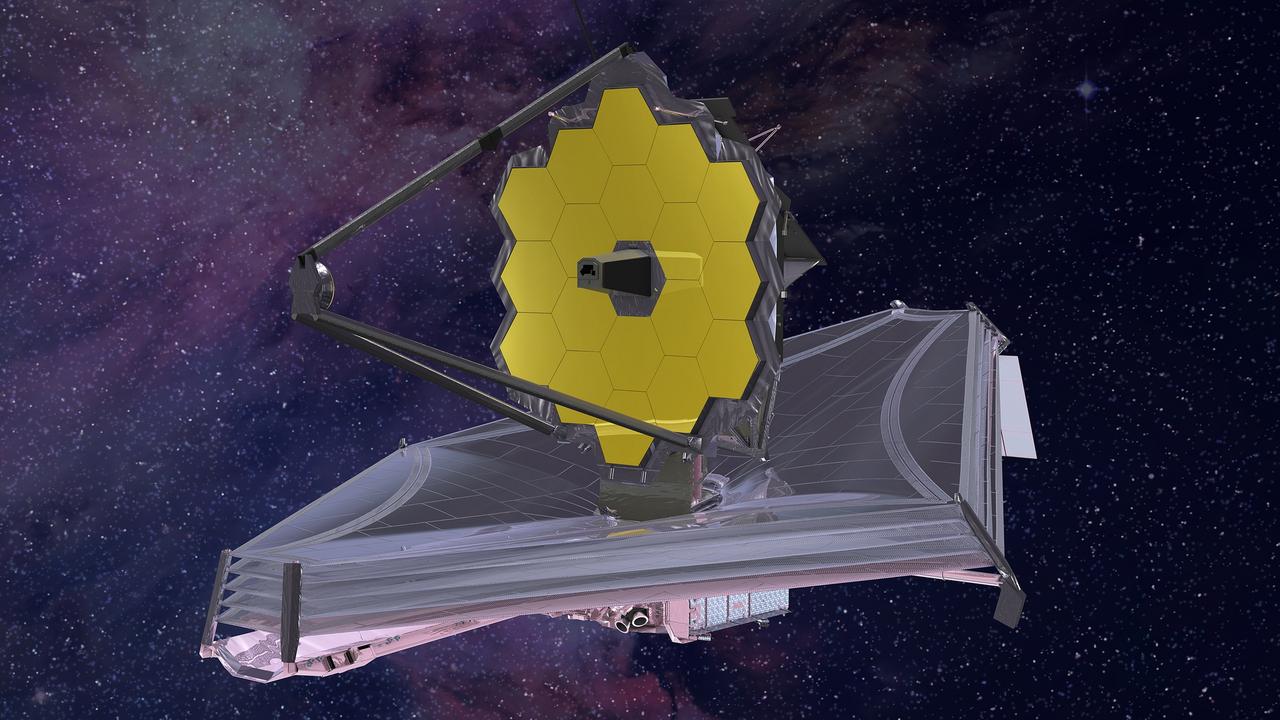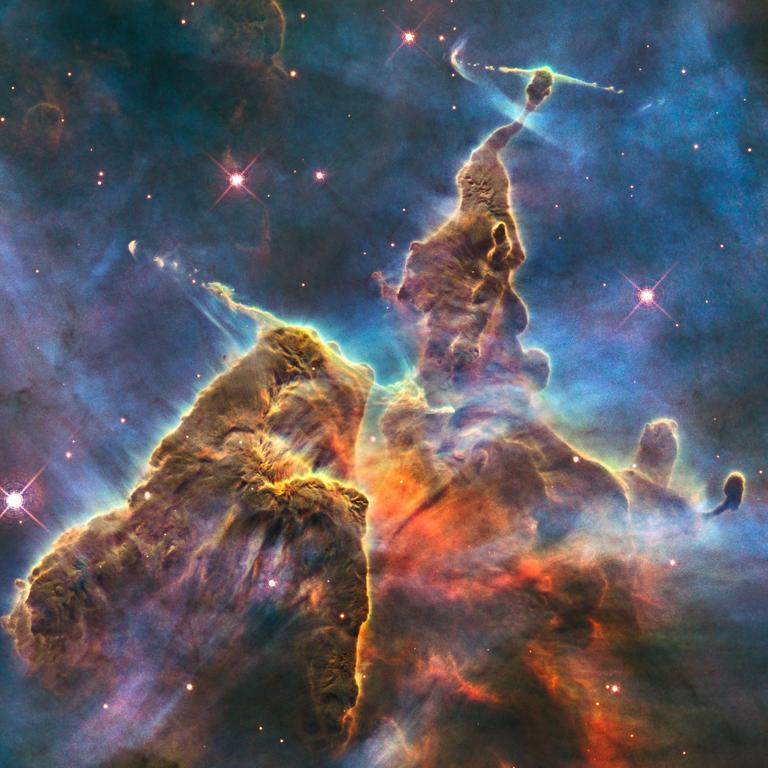NASA’s James Webb Telescope takes deepest picture of early universe
The James Webb Telescope has taken the deepest pictures of the universe to date, showing galaxies billions of light years away.
An incredible image taken by the recently-launched James Webb Space Telescope is taking us back to where the universe started. It’s the most detailed snapshot of our universe to date.
The stunning deep image of galaxies was revealed at a White House briefing by US President Joe Biden, showcasing the “deepest and sharpest infra-red image of the early universe” ever taken.
The photons, travelling towards the telescope for 13 billion years, are like a time machine, and reveal what the universe was like 13 billion years ago.
The image, unveiled on Monday at 5.30pm (US time), revealed thousands of galaxies and features the faintest objects ever observed, colourised from infra-red to blue, orange and white tones.
It is also only a fraction of the observable universe and focuses on the galaxy cluster SMACS 0723, with the photo taken over a period of 12.5 hours.

The image is somewhat similar to the groundbreaking observations by the Hubble Space Telescope — the Hubble Deep Field and Hubble Ultra-Deep Field images.
“Mr President, if you held a grain of sand on the tip of your finger at arm’s length, that is the part of the universe that you’re seeing – just one little speck of the universe,” NASA chief Bill Nelson said.
“What you’re seeing are galaxies, galaxies shining around other galaxies, whose lights has been bent, and you’re seeing just a small little portion of the universe.”
The telescope is the world’s newest and most powerful deep space telescope, and has allowed us to see closer to the dawn of time than ever before.
US Vice President and Chair of the National Space Council, Kamala Harris described the JWST telescope as “one of humanity’s great engineering achievements”.
“The images today are a testament to the amazing work done by he thousands of workers across our nation who dedicated years to this project,” she said.
“Revolutionising” astronomy
Mr Nelson also promised at the briefing that the image was only the first of many to come, with subsequent images to look further and deeper into space.
“That light that you’re seeing on one of those little specs has been travelling for over 13 billion years,” he said.
“And we’re going back further – this is just the first image … we know the universe is 13.8 billion years old we’re going almost back to the beginning.”
Mr Nelson said not only would the telescope help look into the earliest moments of the universe, but the precision and clarity of the telescope will further the exploration for habitable planets.
“It is going to be so precise you’re going to see whether or not planets – because of the chemical composition … are habitable.”

Ms Harris said the telescope and its images represented a “new chapter in the exploration of our universe”.
“From the beginning of history, humans have looked up to the night sky in wonder,” she said.
“And thanks to dedicated people who have been working for decades in engineering and on scientific marvels we can look to the sky with new understanding.
The JWS telescope was launched in December last year as a successor to the famous Hubble telescope.
The $13 billion project is a collaboration between NASA, the European Space Agency and the Canadian Space agency and will enable further investigations into astronomy and cosmology.
Ms Harris said the telescope and its images represented a “new chapter in the exploration of our universe”.
“From the beginning of history, humans have looked up to the night sky in wonder,” she said.
“And thanks to dedicated people who have been working for decades in engineering and on scientific marvels we can look to the sky with new understanding.

“Building on the legacy of the Hubble, the James Webb Space Telescope allows us to see deeper into space than ever before and in stunning clarity.
“It will enable us to enhance what we know bout the origin of our universe, our solar system and possibly life itself.”
The Hubble telescope is renowned for producing the iconic composite image of the Carina Nebula stellar nursery – famous for its towering pillars that include “Mystic Mountain,” a three-light-year-tall cosmic pinnacle.
The past and future of Earth
However it’s not just a glimpse into the past that scientists around the world are waiting for.
Mr Biden said the “historic” project also had immediate significance in shaping our understanding about the future of Earth as a planet.
“It’s like being in a room that is very dark and you only have a little pinhole you can look through,” He said of the previous technology.
But now, with the JWS telescope, “you’ve opened a huge window, you can see all the little details.”
Mr Biden said the significance of the JWS telescope was proof of the importance of space exploration in understanding the Earth’s own future.
“It shows what we can achieve, what more we can discover not just about distant places but about our very own planet and climate,” he said.
“That’s why the American government must invest in science and technology – even more so than we’ve done in the past.”
Mr Biden also said the project was a testament to the strength of the US’s allies.
“Six and a half months ago, a rocket launched carrying the world’s newest and most powerful deep space telescope on a journey one million miles into the cosmos,” he added.
“And as a partnership with others it symbolises the relentless spirit of American ingenuity.”
a full suite of images captured by the James Webb Space Telescope will be released July 12 and will include unprecedented views of distant galaxies, bright nebulae, and a faraway giant gas planet.
An international committee decided the first wave of full-colour scientific images would also include the Carina Nebula, an enormous cloud of dust and gas 7,600 light years away, as well as the Southern Ring Nebula, which surrounds a dying star 2,000 light years away.



